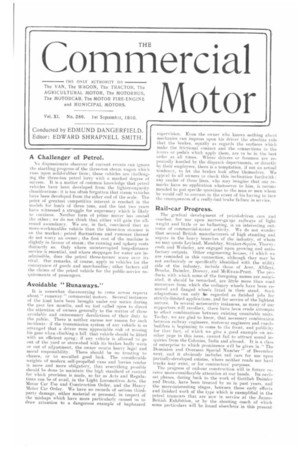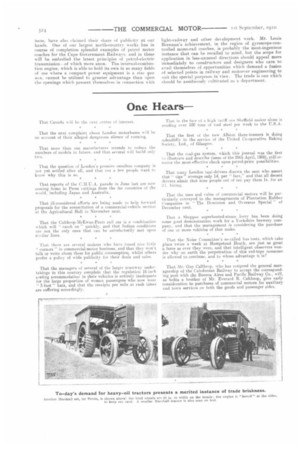A Challenger of Petrol.
Page 1

Page 2

If you've noticed an error in this article please click here to report it so we can fix it.
No dispassionate observer of current events can ignore the startling progress of the three-ton steam wagon which runs upon solid-rubber tires; these vehicles are challenging the three-ton petrol lorry with a marked degree of success. It is a matter of common knowledge that petrol vehicles have been developed from the lighter-capacity classifications; it is too often forgotten that steam vehicles have been developed from the other end of the scale. The point of greatest competitive interest is readied in the models for loads of three tons, and the last two years have witnessed a struggle for supremacy which is likely to continue. Neither form of prime mover has ousted the other; we do not think that either will gain the allround ascendancy. We are, in fact, convinced that no more-workmanlike vehicle than the three-ton steamer is on the market: petrol fluctuations and rumours thereof do not worry an owner ; the first cost of the machine is slightly in favour of steam; the running and upkeep costs distinctly so. Onlywhere uninterrupted long-distance service is essential, and where stoppages for water are inadmissible, does the petrol three-tonner score over its rival. Our remarks, of course, apply to vehicles for the conveyance of goods and merchandise; other factors aid the claims of the petrol vehicle for the public-service requirements of passengers.
Avoidable "Runaways.'
is somewhat disconcerting to come across reports about " runaway " commercial motors. Several instances of the kind have been brought under our notice during the past few months, and we feel called upon to direct the attention of owners generally to the matter of these avoidable and unnecessary derelictions of their duty to the public. There is neither excuse nor reason for such incidents; if the transmission system of any vehicle is so arranged that a driver rims appreciable risk of missing his gear when climbing a hill. that vehicle should he fitted with an efficient sprag; if any vehicle is allowed to go out of the yard or store-shed with its brakes badly worn or out of adjustment, the owner courts heavy legal and moral responsibility. There should be no trusting to chance, or to so-called good luck. The considerable weights of modern self-propelled vans and lorries render it more and more obligatory, that everything possible should be done to maintain the high standard of control for which provision is made, so far as Acts and Regulations can be of avail, in the Light Locomotives Acts. the Motor Car Use and Construction Order, and the Heavy Motor Car Order. We have no records of serious thirdparty damage, either material or personal, in respect of the mishaps which have more particularly caused us to draw attention to a dangerous example of haphazard supervision. Even the owner who knows nothing about inedianics can impress upon his driver the absolute rule that the brakes, equally as regards the surfaces which make the frictional contact and the connections to the levers or pedals which apply them, are to be in the best order at all times. Where drivers or foremen arc repeatedly hustled by the dispatch departments, or directly by their employers, there is a temptation, if not an actual tendency, to let the brakes look after themselves. We appeal to all owners to check this inclination forthwith : any reader of these lines, who may imagine that our remarks have no application whatsoever to him, is memmended to put specific questions to the man or men whom he would call to account in the event of his having to face the consequences of a really-bad brake failure in service.
Rail-car Progress.
The gradual development of petrol-driven cars and conches, for use upon narrow-gauge railways of light weight and little or no ballasting, is an interesting outcome of commercial-motor activity. We do not wonder that several British manufacturers of high standing and repute in the heavy brandies of the industry, of whom we may quote Leyland, Mandslay, Straker-Squire, Thornycroft and Wolseley, are engaged upon growing and satisfactory outputs. Other engineering houses, ef which we are reminded in this connection, although they may be not exclusively or specifically identified with the utility side of the industry, include those of Aver, Alldays, Brooke. Daimler, Drewry, end MeEwan-Pratt. The produets with which some of the foregoing names are associated, it should be remarked, are little more than road motorcars from which the ordinary wheels have been removed and flanged wheels fitted in their stead. Such adaptations can only be regarded as finished jobs for strictly-limited applications, and for service of the lightest nature. In several noteworthy instances, as, many of our supporters will recollect, there have been crude attempts to effect combinations between existing unsuitable units. To-day, we are glad to know, that necessary combination between railway engineers, motorcar engineers and coachbuilders is beginning to come, to the front, and publicity for that fact, of which we give a good example on another page in this issue, cannot fail to attract sound inquiries from the Colonies, India and abroad. It is a class of enterprise to which prominence will be given in " The Dominion and Overseas Special Number " of December next, and it obviously includes rail cars for use upon partially-developed estates, where neither roads nor hard tracks may exist, or for contractors' purposes. The progress of rail-ear construction will in future receive more-considerable attention at our hands. Its earliest phases, dating back to the work of Gottlieb Daimler and Deutz, have been treated by us in past years, and the more-interesting stages, between those early efforts and finished work of the type which is exemplified in the petrol tramcars that are now in service at the JapanBritish Exhibition, or by the shooting coach of which some particulars will be found elsewhere in this present
issue, have also claimed their share of publicity at our hands. One of ear largest north-country works has in course of completion splendid examples of petrol motor coaches for the Cape Government Railways, and in these will he embodied the latest principles of petrol-electric transmission—of which more anon. The inte.rnal-combustion engine, which is able to hold its own in so many fields of use where a compact power equipment is a sine qua lion, cannot he utilized to greater advantage than upon the openings which present themselves in connection with light-railway and other development work. Mr. Louis Brennan's achievement, in the region of gyroscope-conTrolled mono-rail coaches, is probably the most-ingenious instance that can be recalled to mind, but the scope for application in less-unusual directions should appeal more immediately to constructors and designers who care to avail themselves of opportunities which demand a fusion of selected points in railway and motorcar engineering to suit the special purposes in view. The trade is one which should be assiduously cultivated as a department.






















